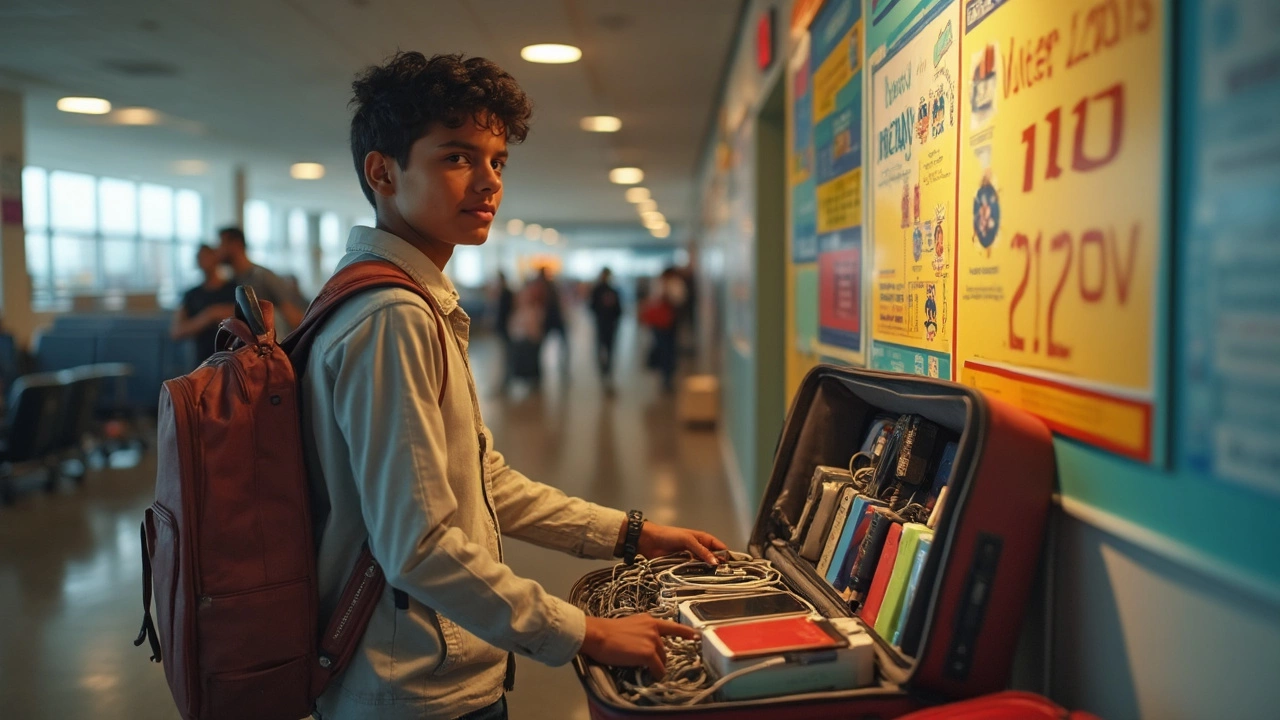So you’ve scored the latest smartphone in Mumbai or a powerful mixer from Delhi, and now you’re planning to use it in the US. You might think it’s as simple as packing your gadgets and hopping on a plane. Not so fast. People fry chargers, blow fuses, and sometimes, even spark a little drama with the wrong plug. Let’s break down what actually happens when Indian electronics meet American power outlets—and how you can keep your gadgets safe (and working) across the Pacific.
Plug Shapes, Voltage, and Frequency: The Real Differences
The moment you arrive in the US and unpack your Indian laptop or hairdryer, you’ll notice something’s off. The plugs don’t fit. That’s not just a minor inconvenience. Here’s what you’re up against:
- Plug Shapes: India mainly uses the Type D and Type M plugs. These are round, chunky, and pretty distinct. The US, on the other hand, loves its flat Type A and B plugs. Plugging an Indian device directly into an American outlet? Not going to happen without an adapter.
- Voltage: India runs at 220 volts, 50 Hz. The US is all about 120 volts, 60 Hz. That’s almost half the voltage in American outlets compared to Indian ones. If your device is built just for India’s higher voltage, it’s going to struggle—or might just refuse to work—on American power.
- Frequency: Hertz (Hz) describes the number of cycles per second. India’s 50 Hz is different from the US’s 60 Hz. Some electronics care about this, while others don’t. Motors, clocks, and certain appliances can run weird or inefficient if the frequency doesn’t match up.
Check out this quick voltage and frequency table to keep things straight:
| Country | Voltage | Frequency | Main Plug Types |
|---|---|---|---|
| India | 220 V | 50 Hz | D, M, C |
| USA | 120 V | 60 Hz | A, B |
The basic math: If your device is not rated for dual voltage (both 110V and 220V), you’ll need a solution. And ‘forcing’ a plug is never a good idea. You don’t want to test your luck with electricity.
Which Indian Devices Work in the USA—And Which Won’t?
Now for the reality check. Some electronics glide through the switch between countries. Others—like that trusty mixer grinder or your old college iron—might give up the ghost if you force the issue.
- Dual-voltage devices: This category is your best friend. Many modern phone chargers, laptops, cameras, and toothbrushes are clever enough to handle both 110V and 220V. Flip them over, read the tiny print. If it says “Input: 100-240V, 50/60Hz”, you’re safe. All you need is a plug adapter, and you’re all set.
- Single-voltage devices: Here’s where trouble brews. An Indian hair dryer, mixer, or juicer—unless specifically marked for dual voltage—can fry or just not work at all in the US. Plugging a 220V-only device into a 120V outlet in the States usually means it will run weakly, or not at all. The opposite (US device in India) is even worse: explosions or smoke are pretty common stories.
- Motors and clocks: These love their frequency. If the Indian device wasn’t built with a 60 Hz motor, it might buzz, run hot, or overheat in the US. Some clocks will lose or gain time. Appliance motors can heat up quickly, which isn’t safe.
- Chargers and gadgets: Most recent-brand chargers are global travelers. It’s your legacy devices (the ones with fabric cords or that old cassette deck) that need a closer look.
Here’s an example: Indian MacBook charger? Likely just needs a plug adapter, because Apple’s gear usually supports worldwide voltages. That aging Bajaj mixer? That’ll need much more than an adapter—think of a voltage converter or maybe even leave it at home. Honestly, more than a few Indian students have tried to bring their mixie to the US for their daal cravings, only to end up in the emergency room or with ruined gear. It happens every year.

Adapters, Converters, and Workarounds: What You Need
Feeling overwhelmed? Don’t be. Here’s what you actually need to know—and buy—if you want your Indian gadgets to survive (and thrive) in the US.
- Plug adapters: These are cheap and everywhere—think $2–$10. They physically let you fit your Indian plug into an American socket. Important to remember: they do not change voltage. So the device needs to be dual voltage or it’s risky.
- Voltage converters: These are serious. They step up or step down voltage between the US’s 120V and India’s 220V. Good converters aren’t tiny; they’re as big as a brick and heavier than you want in your hand luggage. Prices range from $15 all the way up to $75+, and quality matters—a bad one can fry your device or trip breakers. Watts rating is everything: don’t use a 50W converter with your 750W mixer, or you’ll burn out both.
- Universal travel adapters: These add convenience but sometimes compromise on safety. Get one with surge protection; you can find them on Amazon or in airports, but make sure they support both the plug shape and the voltage you need.
- Never try to force a fit: Jamming a round pin into a flat socket is a great way to short-circuit your new apartment or cause a small fire. Not kidding.
- Check the label: Manufacturers put all the real info on the back or bottom of your device. “100–240V” is your green light. If you see only “220V 50Hz”, you must use a converter.
- Consider buying locally: At some point, it just isn’t worth it. Small, high-wattage appliances (hair dryers, electric kettles, microwaves) are often cheaper and safer to just buy in the US than to haul (and adapt) from India.
Pro tip: Look for the maximum wattage supported by your converter. Complex devices like induction cooktops or heavy blenders may not work, even with a step-up/step-down converter. And don’t run them for too long—these converters can overheat during extended use.
Here’s a quick comparison table of what’s worth carrying:
| Device Type | Recommended Approach |
|---|---|
| Laptop, mobile phone, camera | Plug adapter (check for dual voltage) |
| Small kitchen appliances (blender, mixer) | Strong converter (check wattage) |
| Hair dryer, straightener | Buy local or use high-watt converter |
| Electric razor, toothbrush | Usually dual voltage, plug adapter |
| Heaters, iron | Buy local |
Modern Tech Trends, Pitfalls, and Local Hacks
Tech is moving fast. A decade ago, many devices weren’t global-friendly. Today, more manufacturers make life easy for travelers. If you’re bringing brand-new electronics from India—especially phones, tablets, laptops, or cameras—Indian electronics usually work in the US with minimal hassle. Just watch out for smaller, older, or specialty appliances.
If you’re stuck and desperate, you can sometimes find Indian plug adapters in the ‘international students’ section of American supermarkets near big universities. Some Indian grocery stores in the US even sell converted mixers and spare cords, because there’s so much demand. There are Facebook groups and community forums dedicated to these hacks; plug in your city and you’ll likely find what you need or someone who will lend you a converter for your first few weeks.
BUT, don’t trust whatever you find off the internet. Don’t buy the cheapest adapter on Amazon—read the reviews, especially the one-star ones. About 13% of large appliance damages in apartments rented by newcomers get traced back to incorrect adapters, according to a New Jersey property management survey in 2023. Damaged devices can void your warranty, and some landlords really don’t like electrical surprises.
If you plan on being in the US for a while, it usually makes much more sense to go local. American appliances are designed for the local grid, have proper plugs, and are much easier to replace or repair if something goes wrong. And hey, you might even find a few gadgets you didn’t know you needed (like a waffle maker!).
Quick travel tip: If you’re just passing through the US, or you’re a student staying for a semester, pack only what you can easily adapt. For everything else, there’s Target, Walmart, or Best Buy.
So next time you’re eyeing that powerful Indian mixer or electric kettle, ask yourself—does it speak both 220V and 120V? Would a US model make your life easier? And if you must bring it, double-check the wattage, buy a trusted adapter or converter, and let your roommates know what that weird buzzing sound is about.
